
Khanfar Spectrum Analyzer
Our flagship software for professional SDR signal analysis and visualization
Key Features
Real-time Analysis
Live signal visualization and FFT analysis with professional-grade accuracy
Multiple Views
Waterfall, 2D, and 3D visualization modes for comprehensive signal analysis
Multi-Device Support
Support for unlimited RTL-SDR devices with automatic detection and management
Smart Device Management
Automatic detection of available devices and intelligent busy-device skipping
Advanced Controls
Precise frequency selection and customizable sampling rates
Real-time Updates
Continuous signal monitoring with minimal latency
Setup Guide
1. Connect Your Devices
- Connect your RTL-SDR dongles to USB ports
- Wait for Windows to recognize the devices
- Multiple devices can be connected simultaneously
2. Launch the Software
- Run Khanfar Spectrum Analyzer
- The software will automatically detect available devices
- Select your preferred device from the list
- Busy devices will be automatically skipped
Technical Specifications
Hardware Support
- All RTL-SDR devices (RTL2832U)
- Multiple device simultaneous operation
- Automatic device detection and management
- Smart busy-device handling
Signal Analysis
- Real-time FFT processing
- Configurable sample rates
- Multiple visualization modes
- Advanced filtering options
Performance
- Low-latency processing
- Efficient resource usage
- Optimized multi-device handling
- Real-time updates
Gallery
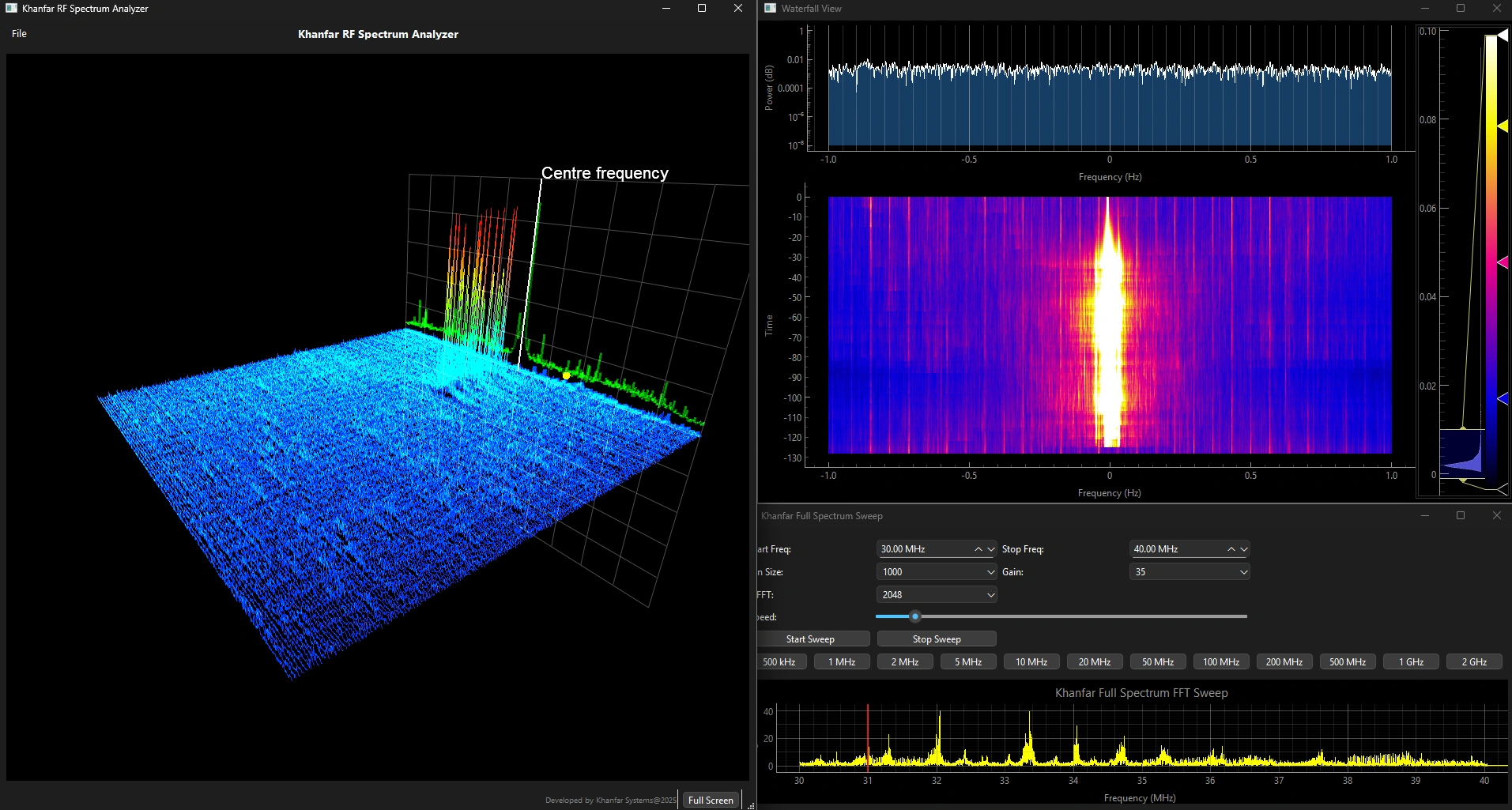

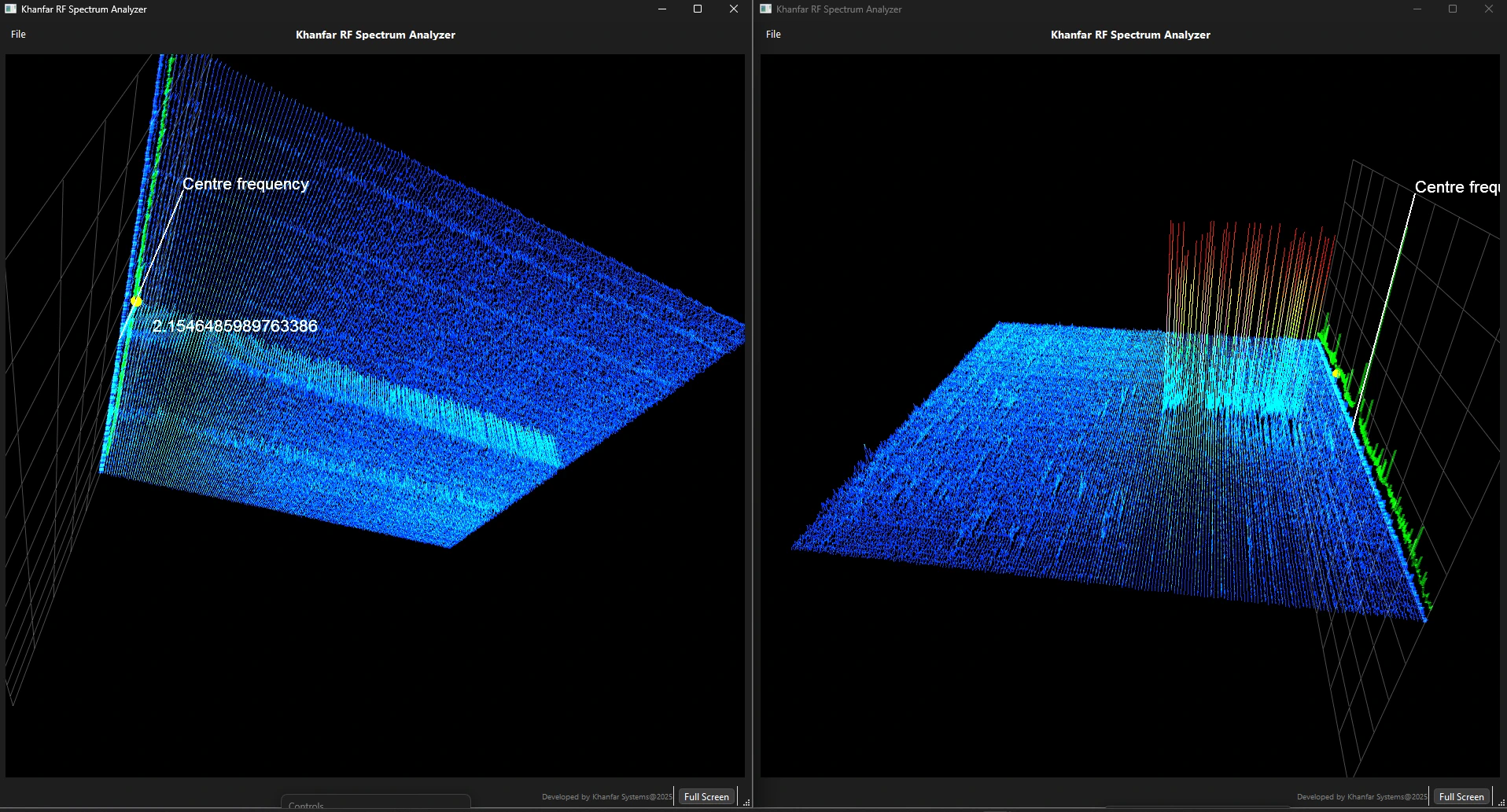
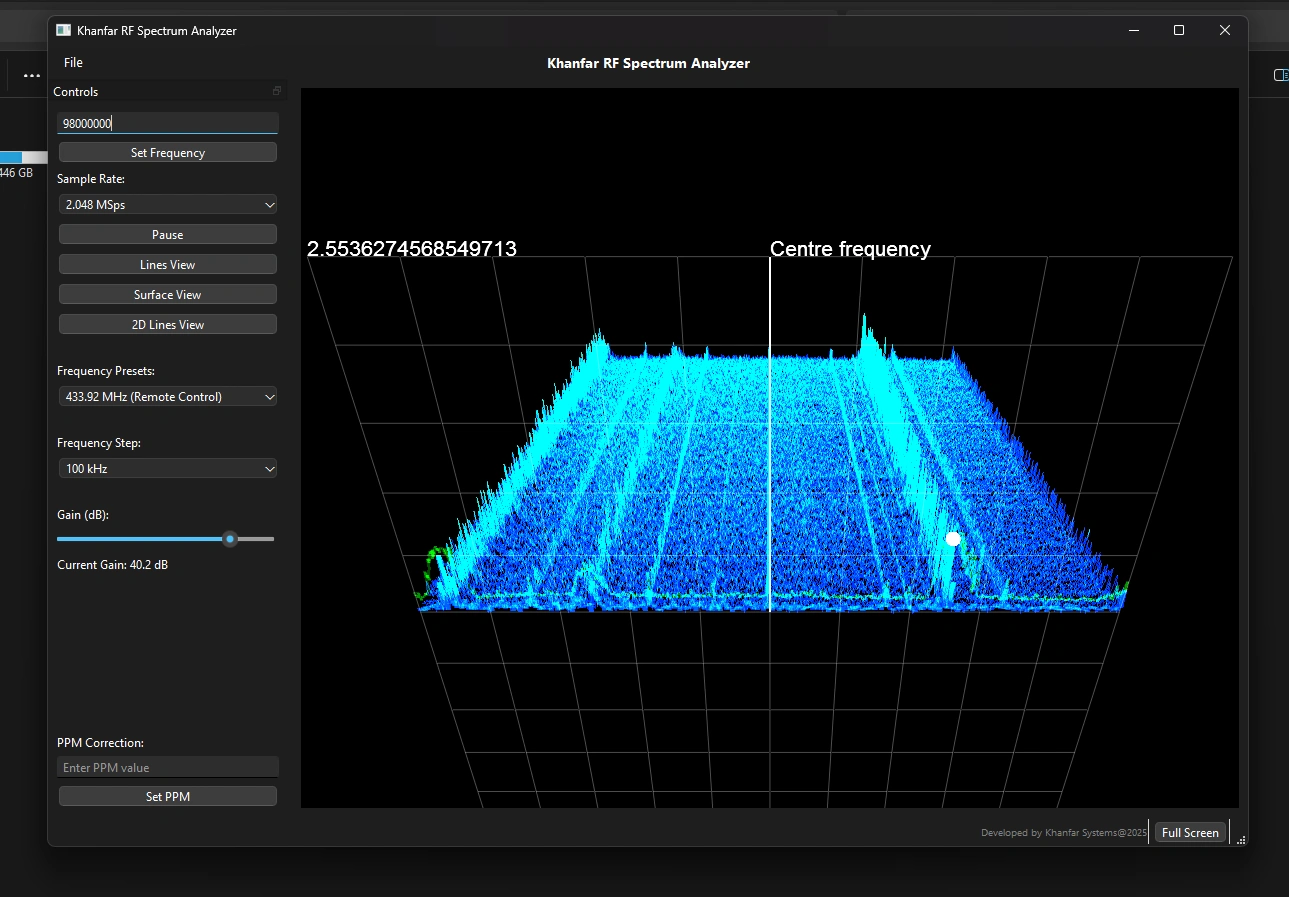
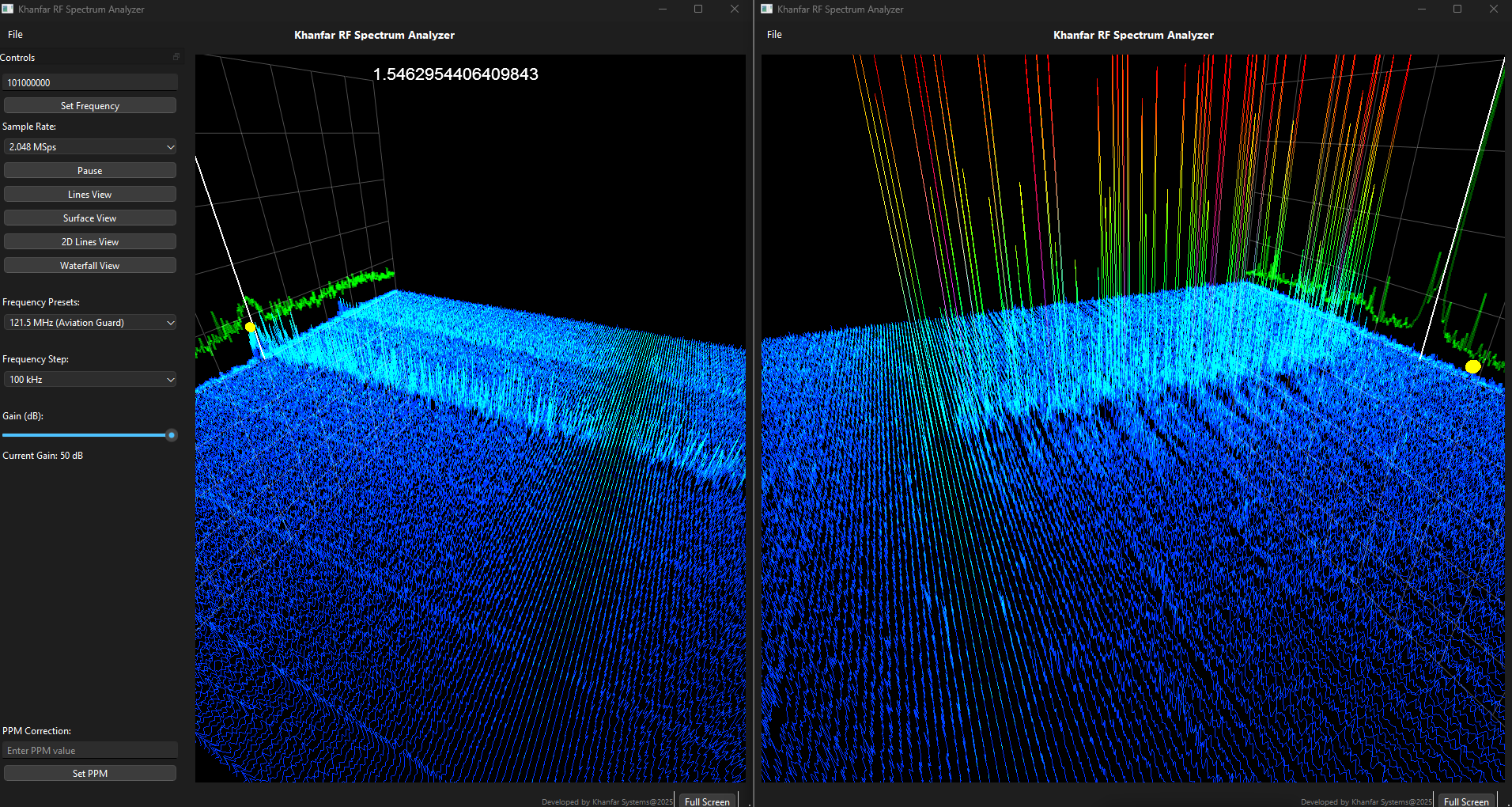
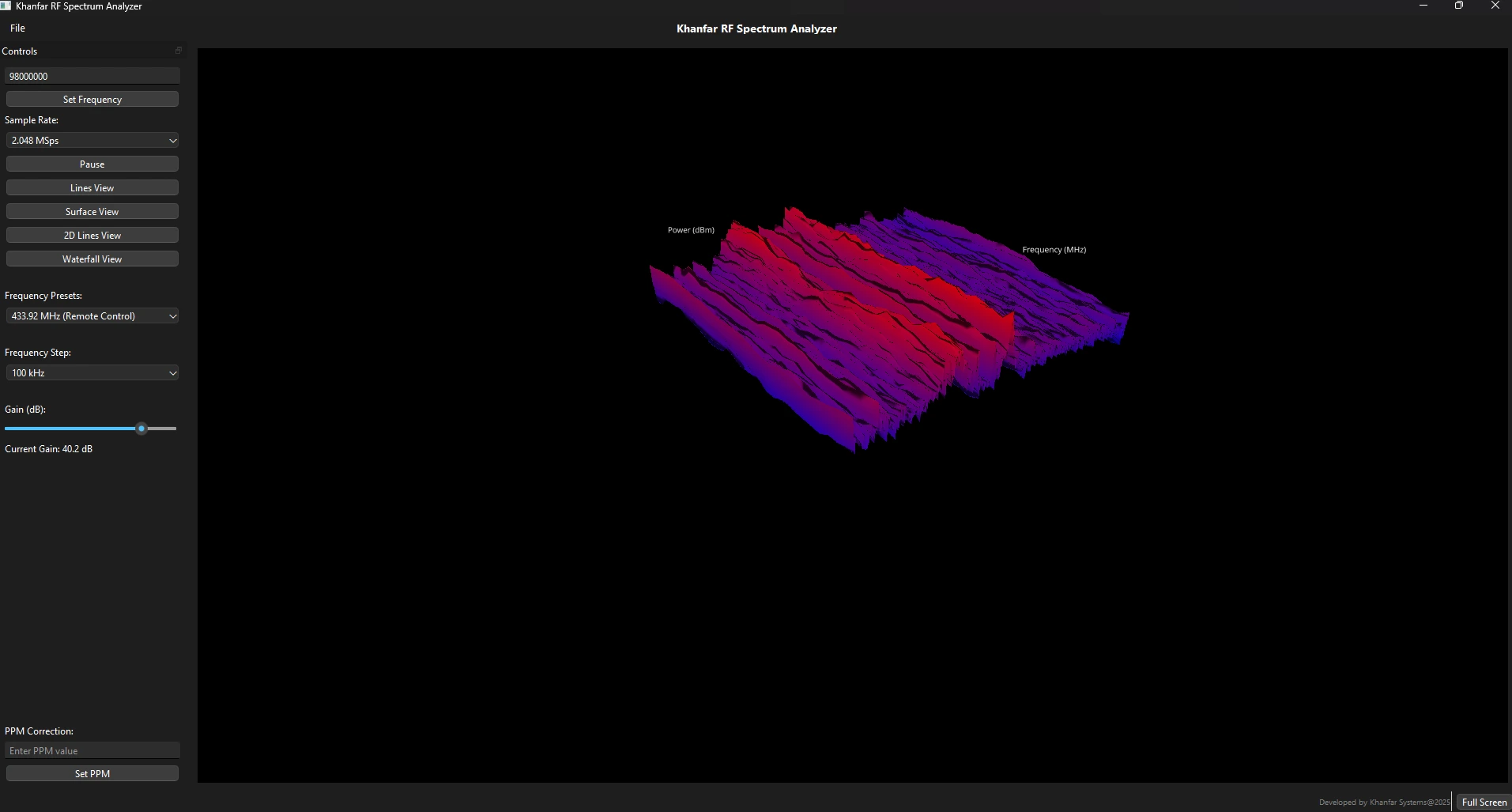
System Requirements
Hardware
- RTL-SDR USB dongle(s)
- USB 2.0 or higher ports
- 2GB RAM minimum
- Dual-core processor or better
Software
- Windows 10/11
- Zadig USB driver utility
- WinUSB driver
- .NET Framework 4.7.2 or higher
Khanfar Spectrum Analyzer

Professional SDR Analyzer
Our flagship software for comprehensive signal analysis with multi-device support and advanced visualization capabilities.
- Real-time FFT and waterfall displays
- Multi-device support with auto-detection
- 2D and 3D visualization modes
- Precise frequency tuning and sampling
- Smart device management
- Low-latency processing
Additional Software
Explore our collection of specialized SDR tools designed for specific signal processing tasks
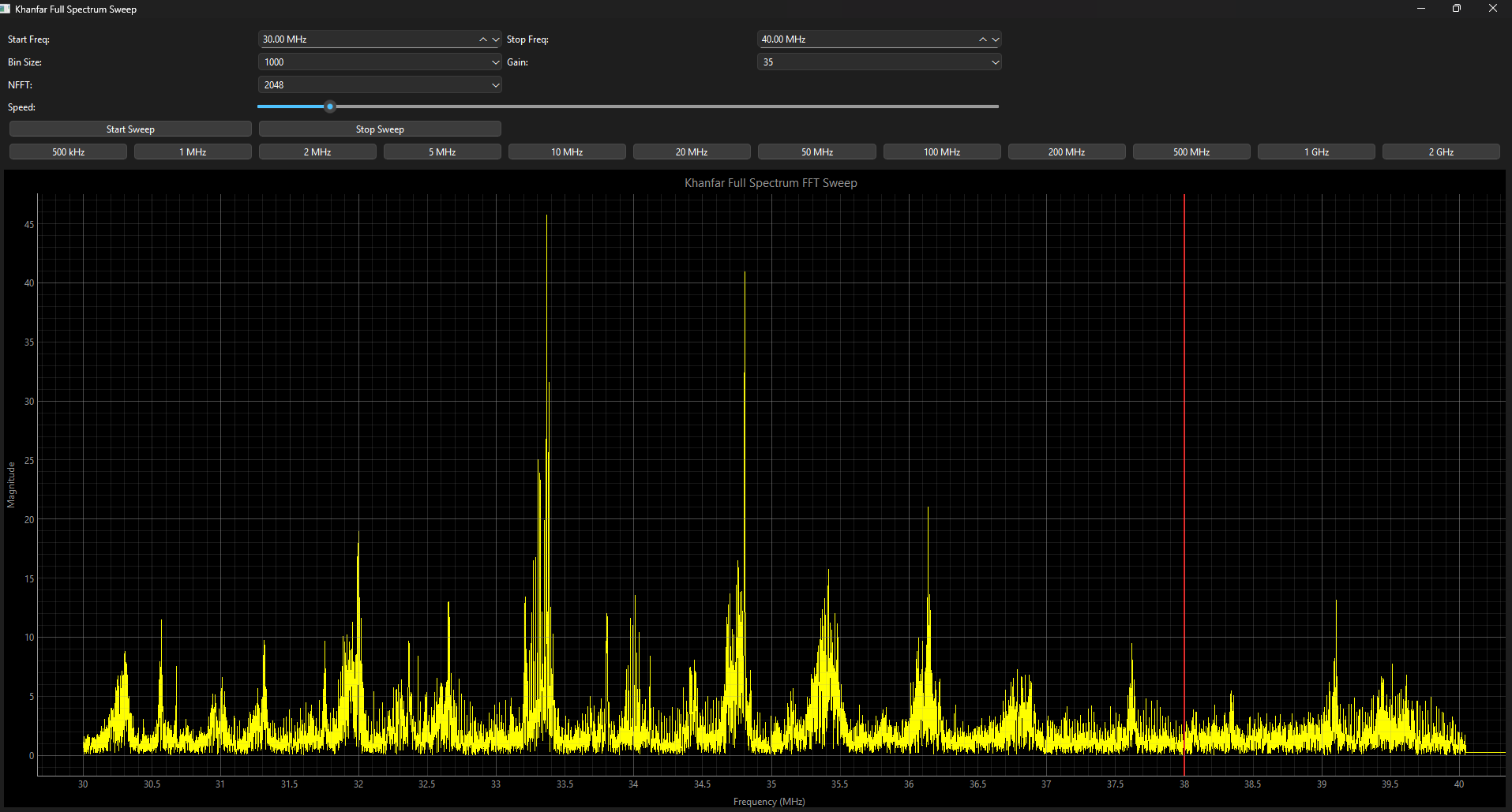
Khanfar RTL Sweeper
A powerful spectrum analyzer for RTL-SDR devices with real-time FFT analysis capabilities.
- Multi-device support with automatic detection
- Real-time FFT spectrum analysis
- Adjustable frequency range and gain
- Visual spectrum display with sweep line
- Customizable sweep speed and bin size
- User-friendly interface with preset spans
Unzip Password: 1234

Khanfar Advanced Spectrum Analyzer
A comprehensive spectrum analysis tool for advanced signal monitoring and analysis.
- Advanced signal processing algorithms
- Multiple visualization modes
- Real-time frequency analysis
- Customizable display settings
- Signal strength monitoring
- Frequency band scanning
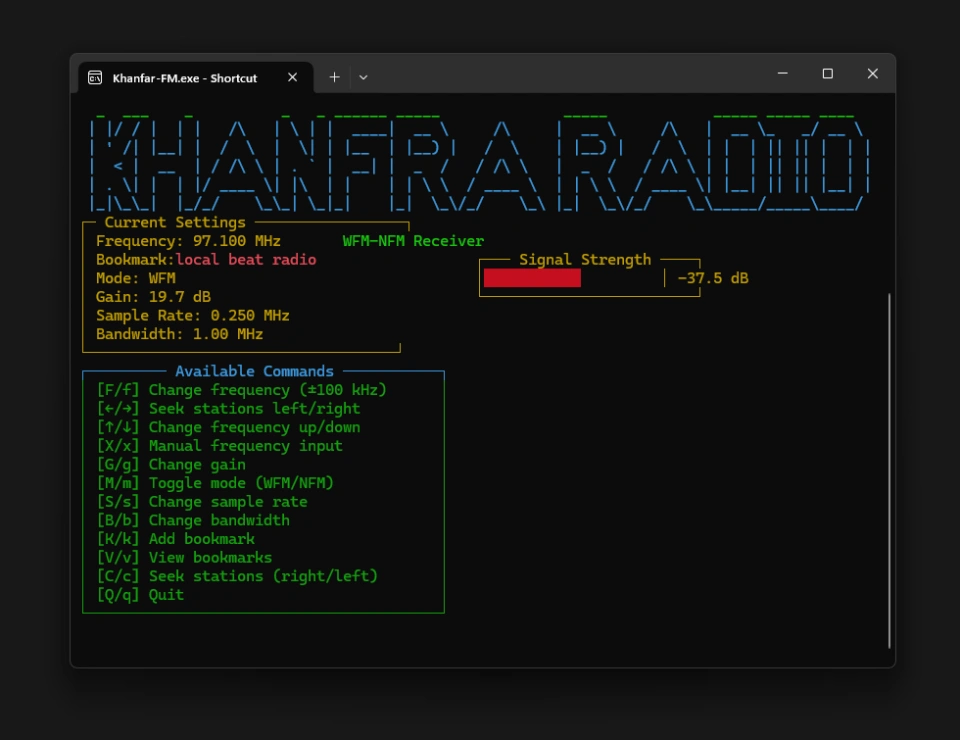
Khanfar-FM Radio
Professional FM radio receiver with advanced signal processing and station management capabilities.
- Wide FM (WFM) and Narrow FM (NFM) demodulation
- Full frequency coverage (24 MHz - 1766 MHz) for NFM
- Commercial FM band coverage (87.5-108 MHz) for WFM
- Smart station scanning and bookmarking
- Real-time signal strength meter
- High-quality audio output (44.1 kHz)
- Advanced de-emphasis filtering
- Multiple sample rate presets (250 kHz - 2.4 MHz)
- Flexible gain control (0-49.6 dB)
Unzip Password: 1234
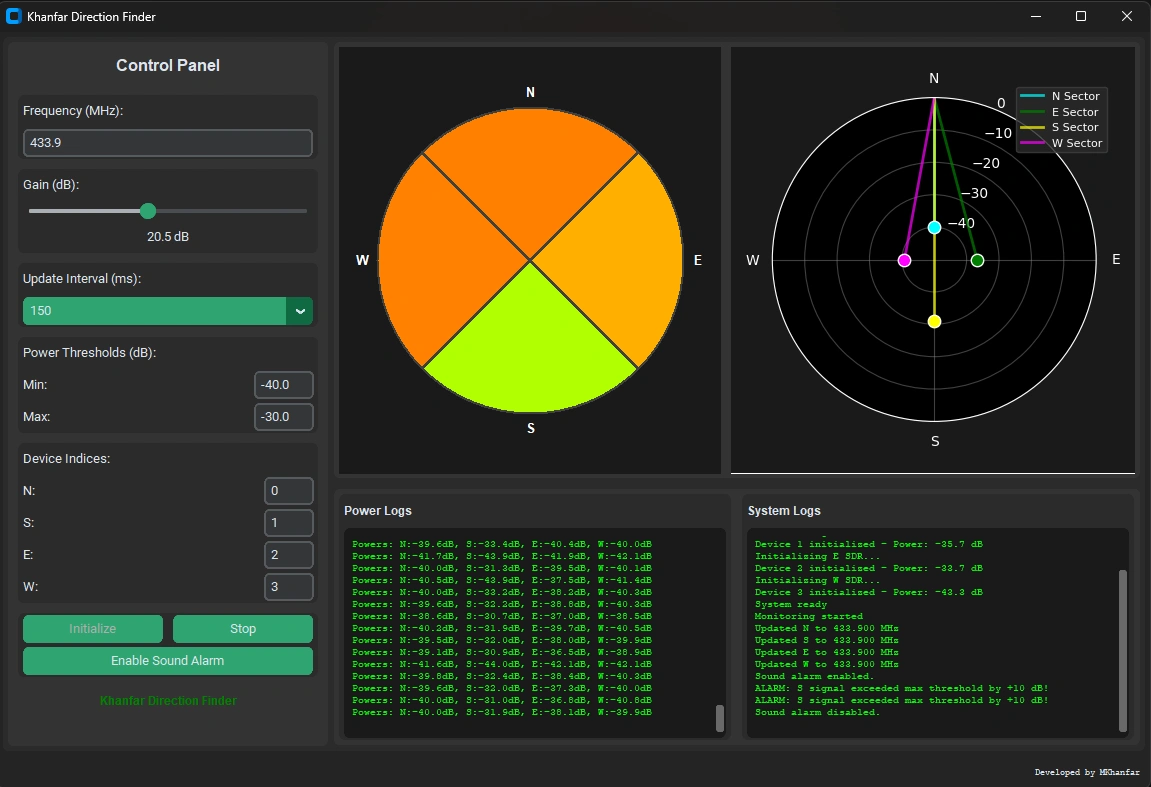
Khanfar Direction Finder
Professional radio direction finding system with quad-SDR triangulation and real-time bearing calculation.
- 4x RTL-SDR simultaneous operation
- Real-time signal power measurement (4096 samples/reading)
- Adaptive threshold-based alarms (visual/audio)
- Polar plot & compass visualization
- Frequency range: 24MHz - 1.766GHz
- 28-step gain control (0-49.6 dB)
Technical Specifications:
- Sample Rate: 2.4 MS/s
- Bandwidth: 1.2 MHz
- Update Interval: 50-200ms
- FFT Size: 4096 points
- Supported Hardware: RTL2832U-based SDRs
Antenna Systems
Log-Periodic Dipole Arrays (LPDAs)
The Swiss Army knife of DF antennas! These wideband beasts cover 100 MHz to 2 GHz with 8+ dBi gain. Precision-tuned elements ensure phase coherence across all 4 SDRs.
- Frequency Range
- 100 MHz - 2 GHz
- Gain
- 8-12 dBi
- Beamwidth
- 60°-90°
- Front-to-Back Ratio
- 15-20 dB
Setup Configuration:
- Align 4 LPDAs at 90° intervals (N/S/E/W)
- Use identical 50Ω coaxial cables
- Software configuration:
- Set bandwidth to 144-148 MHz for narrowband operation
- Enable phase correlation analysis
Yagi-Uda Antennas
- Gain
- 15 dBi
- Beamwidth
- 30°
- Frequency Range
- Single-band optimized
Operational Tips:
- Mount on motorized rotators for bearing refinement
- Enable threshold alarms for weak signals
- Use with LNA for distant targets
Helical Antennas
- Beamwidth
- 70°
- Frequency Range
- 400-1700 MHz
- Applications
- GPS, 915 MHz ISM, 1.2 GHz FPV
Deployment Notes:
- Ideal for mobile tracking applications
- Use circular polarization for multipath rejection
- Pair with LNA for satellite tracking
Narrowband DF Optimization:
- Tune LPDAs to specific frequency band (e.g., 144-148 MHz)
- Use logarithmic element scaling for consistent performance
- Monitor phase coherence between array elements

Khanfar Direction Finder QUINTET Version
Enhanced radio direction finding system with quad-SDR plus central SDR omnidirectional antenna for superior triangulation and signal analysis.
- Central SDR Integration: Added a fifth SDR for improved triangulation and analysis
- Interactive Map View: Visualize signals on a map with offline tile caching
- Triangulation Mode: Determine signal source Direction using advanced triangulation
- Configuration Management: Save and load settings automatically
- Enhanced User Interface: Scrollable control panel and improved layout
- Advanced Signal Processing: Dynamic signal distance calculation and improved reconnect logic
Additional Features:
- Offline Map Support: Cache map tiles for offline use
- Additional Controls: Latitude/longitude input and max signal distance setting
- Error Handling and Logging: Improved diagnostics and error recovery
- Visual Enhancements: Updated heatmap colors and compass design
- Performance Improvements: Optimized update intervals and thread management




Quad 3D Spectrum Analyzer
Advanced 3D visualization system for multiple RTL-SDR devices with real-time spectrum analysis and interactive controls.
- Simultaneous operation of 4 RTL-SDR devices
- Real-time 3D waterfall visualization
- Independent frequency and gain control for each SDR
- Global frequency mode with "Sandwich View"
- Peak detection and visualization
- Movable control panel with intuitive interface
- Automatic device detection with fallback options


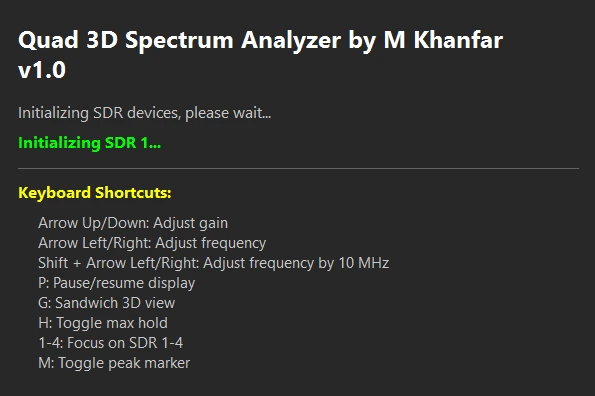



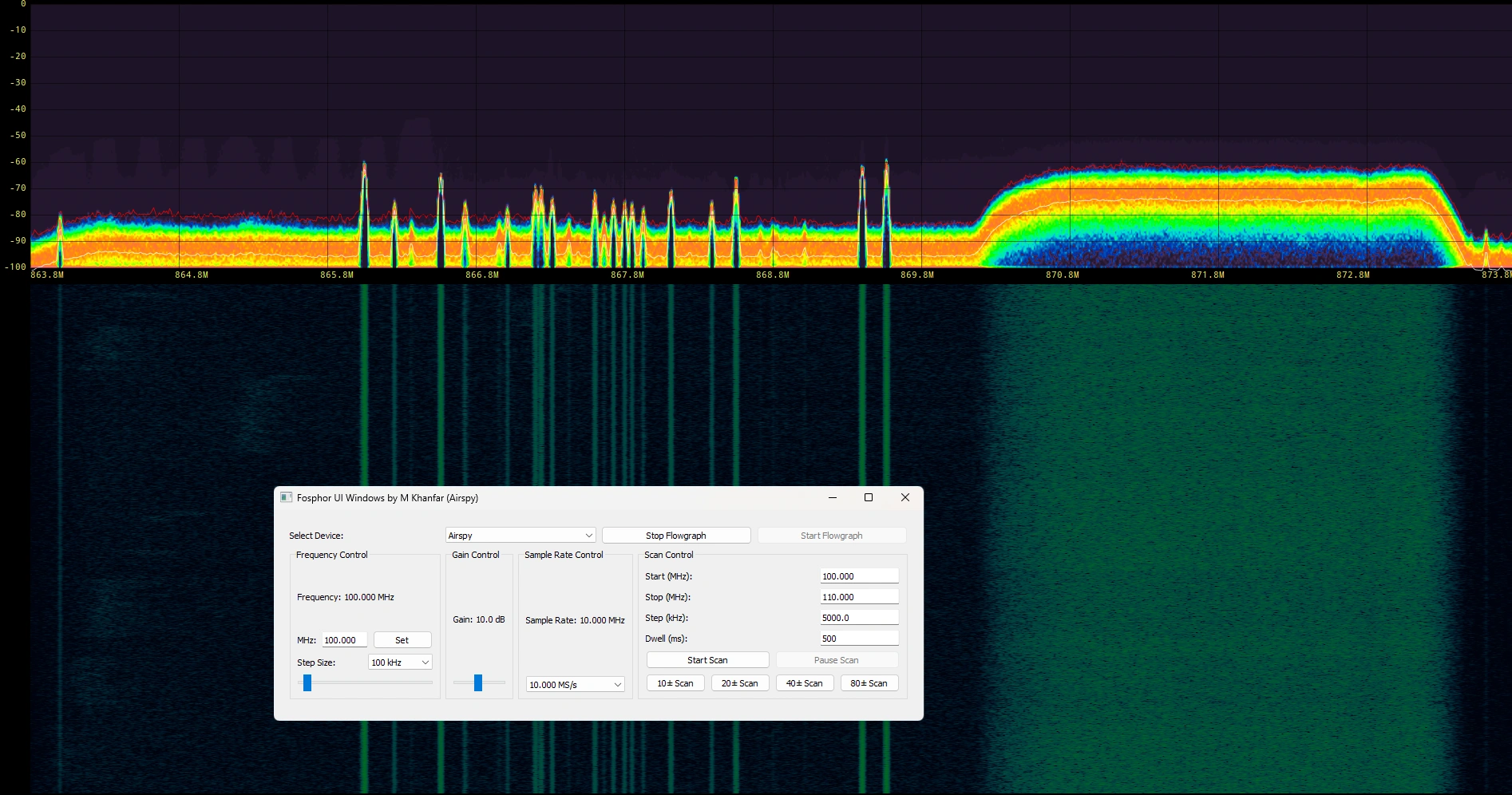
Fosphor Spectrum Visualization Windows Version
Real-time GPU-Accelerated Spectrum Visualization for SDR Enthusiasts
Fosphor Spectrum Visualization is a powerful, open-source software tool designed for real-time signal analysis using Software-Defined Radio (SDR) devices. Built on GNU Radio and leveraging GPU acceleration, it provides a seamless experience for monitoring RF spectra with exceptional performance and visual clarity.
- Windows support stand-alone version ready to use
- Multi-SDR Support: Compatible with RTL-SDR, Airspy, and HackRF devices
- Auto-detects connected SDR hardware for plug-and-play usability
- GPU-Accelerated Visualization: Uses Fosphor, a high-performance GPU-based spectrogram engine, for smooth real-time rendering (OpenGL support required)
- Fallback to CPU-based QtGUI plots (spectrum/waterfall) if GPU drivers are unavailable
- Intuitive Control Panel: Adjust frequency, sample rate, and gain via sliders or direct input
- Keyboard shortcuts for efficient control
- Device-Specific Optimization: Automatically validates and adjusts parameters (frequency, gain, sample rate) to device capabilities
- Preset defaults for RTL-SDR, Airspy, and HackRF ensure optimal performance
- Real-Time Spectrum & Waterfall Displays: Interactive spectrogram with dB-scale adjustments
- Simultaneous frequency spectrum and waterfall views for detailed signal analysis
- User-Friendly Interface: Clean, Windows 10-11 compatible GUI with device selection, start/stop controls, and parameter readouts
- Responsive design adaptable to different screen sizes
- Advanced Signal Processing: Built-in correction for frequency offsets
- Frequency Scanning Functionality: Customizable scanning with start/stop controls
- Preset Scan Buttons: Quick ± range scans around the center frequency
- Enhanced Keyboard Shortcuts: Faster frequency tuning and scan control
- 3D Visualization (Beta 1.2): Interactive 3D spectrum view for enhanced signal analysis
Technical Highlights:
- GPU Backend: OpenGL-powered spectrogram for minimal latency
- Open Source: Fully customizable under the GNU license
- It is getting its name from Phosphor, materials that exhibit slow decay of light, which are used in radar screens and CRT displays. Fosphor is essentially a spectrum analyzer, but it is a beautiful one, a convenient one and very suitable for real-time and burst signal applications.
- This project's main developer is Sylvain Munaut, who is working on this as part of the Osmocom project. Fosphor and GNU Radio are free, open-source projects licensed under the GPL license.
Fosphor UI Elements:
- Live spectrum – a red line showing frequencies of the signal in the window
- Waterfall – the bottom part of the window showing frequencies in time on the time axis
- Histogram – the top part of the window showing frequencies in time as a histogram
- The live spectrum and waterfall are pretty standard, though nicely done, detailed, responsive and clearly colored. The histogram "charges" and "discharges" over time, making it easy to notice short bursts of signal.
New Features Details:
- Frequency Scanning Functionality:
- Users can set start frequency, stop frequency, step size (kHz), and dwell time (ms) via text inputs.
- "Start Scan" and "Pause Scan" buttons to control scanning, with keyboard shortcuts ('O' to start/stop, 'P' to pause/resume).
- Automatically loops from start to stop frequency, stepping by the specified increment.
- Dwell time adjustable down to 50ms for rapid scanning!
- Preset Scan Buttons:
- Added preset scan buttons for quick ± range scans around the center frequency.
- Simplifies rapid analysis of frequency bands with predefined ranges.
- Enhanced Keyboard Shortcuts:
- '+' or '=': Increase frequency by the step size (default 100 kHz, adjustable via dropdown).
- '-': Decrease frequency by the step size.
- 'O': Start or stop the scan.
- 'P': Pause or resume the scan.
- Note: "Keyboard shortcuts for frequency tuning (+/-) and scan control (O/P) for faster operation."
- 3D Visualization (Beta 1.2):
- Interactive 3D spectrum rendering for a deeper understanding of signal behavior
- Adjustable viewing angles and zoom for detailed inspection
- Enhanced GPU utilization for smooth performance
Additional Features:
- Zoom: Splits the display vertically and lets you select a narrow frequency band of interest
- Pause: Stops processing and lets you closely examine an interesting signal before it scrolls away
- Scale: Changes the dB scale and offset to hide noise and focus on key signals
- Keyboard Shortcuts:
z: Toggle zoom modea/d: Move zoom frequency down/ups/w: Adjust zoom widthq/e: Adjust screen split between waterfall and FFT/histogramspace: Pause display(left)/(right): Adjust dB/div(up)/(down): Adjust dB offset
Fosphor Main Parts:
- FFT: Processes every sample at the input in at least one FFT window
- Live Spectrum: IIR average of all computed spectra for smooth responsiveness
- Waterfall: Displays all spectra with potential future aggregation
- Histogram: Statistical view of spectra, perfect for bursts and transients
License Information
This software is published under the GPLv3 license. The original Fosphor project is developed by Sylvain Munaut as part of the Osmocom project and is available at: https://github.com/osmocom/gr-fosphor
We have created a Windows executable version of this tool under the same license. Our source code is available at: https://github.com/e4mwak/RTL-SDR-Fosphor-Spectrum-Analyzer
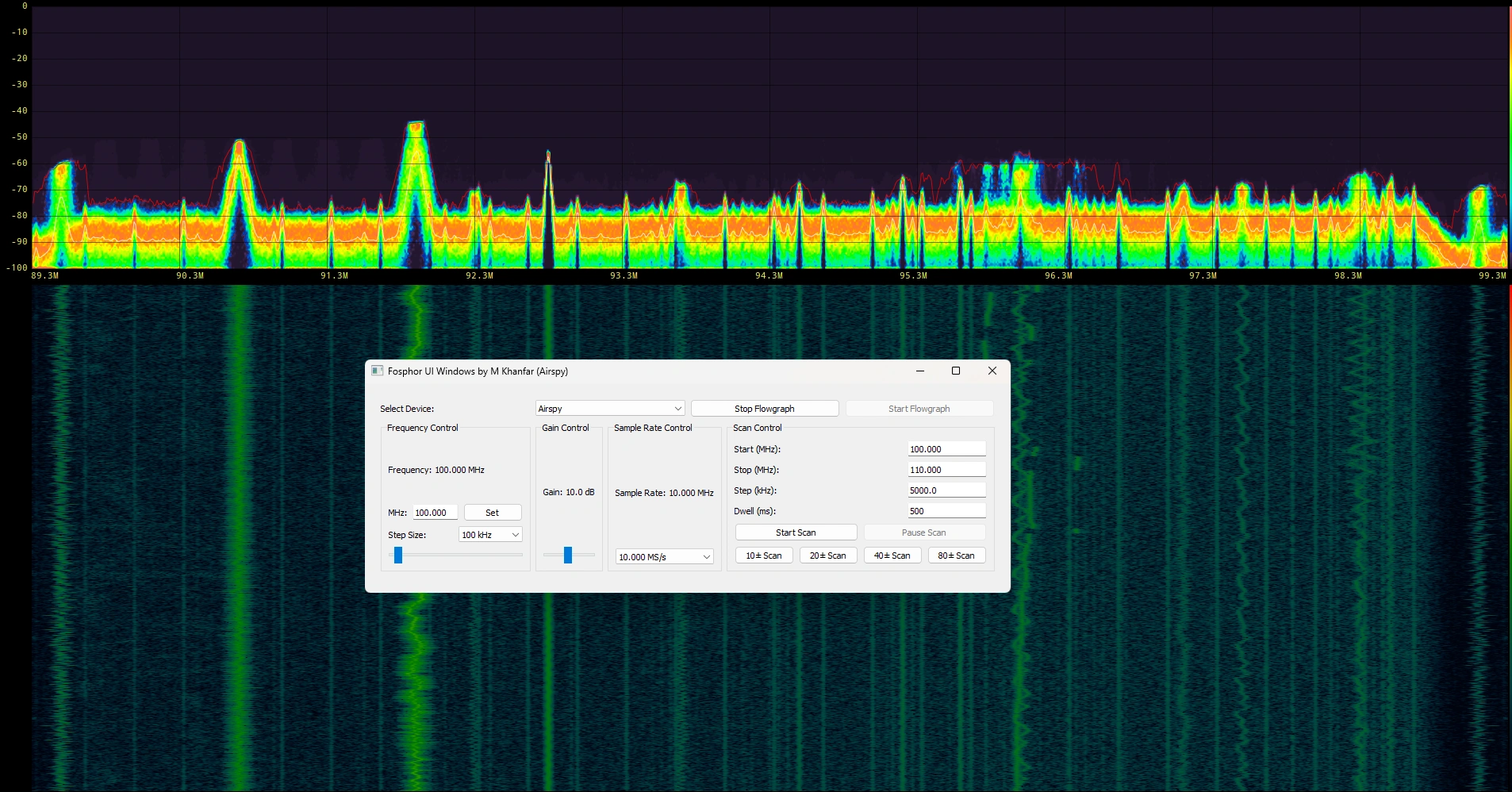
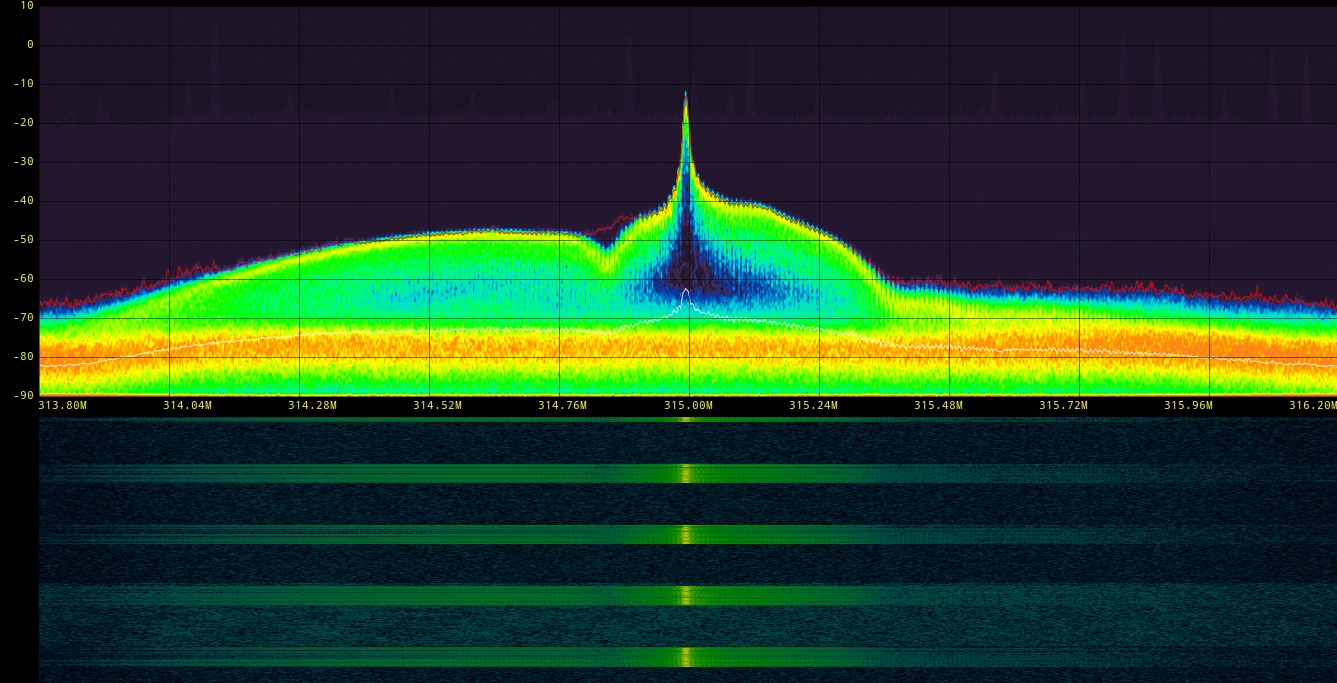
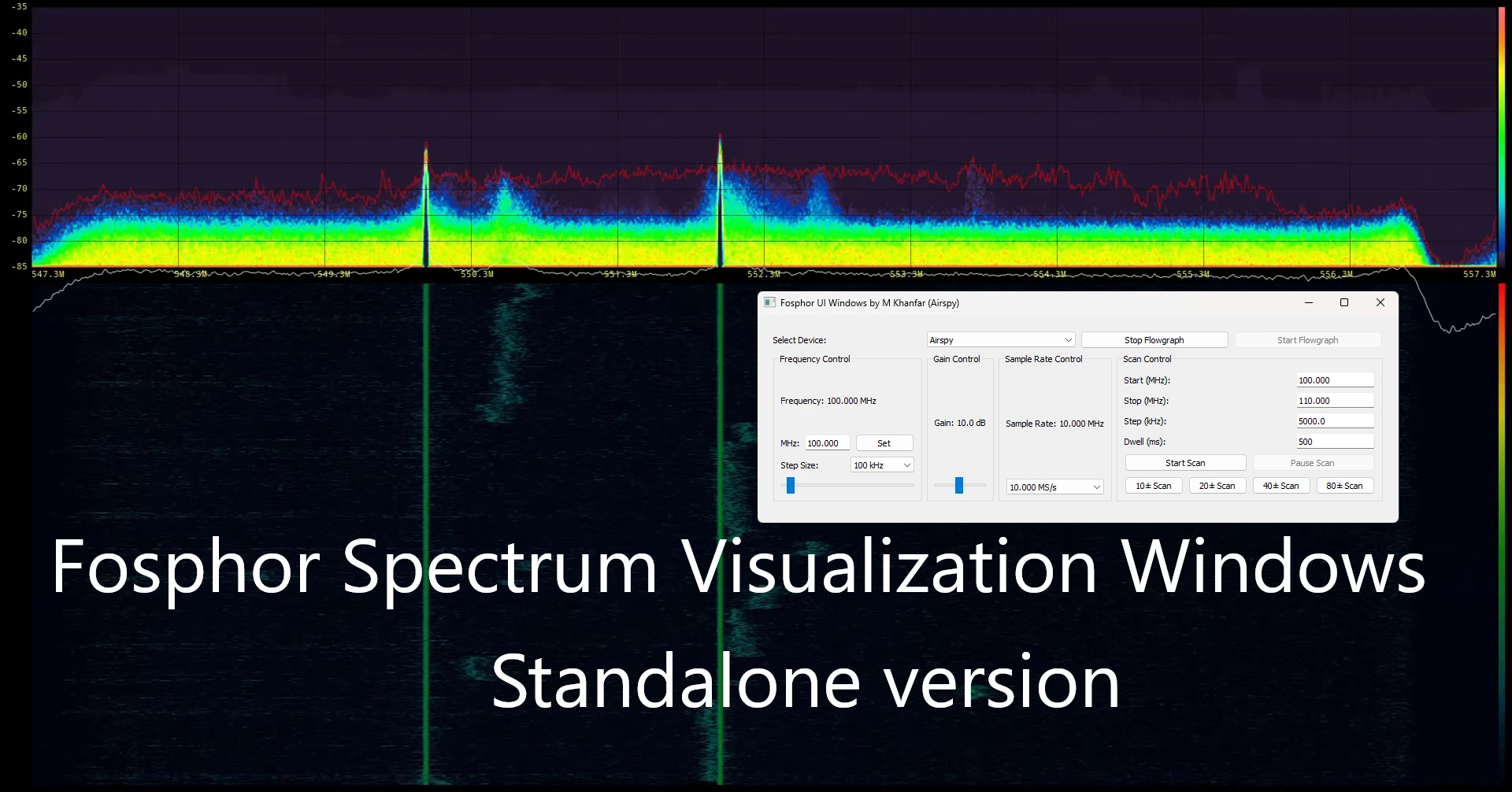

stable version - Unzip Password: 1234
Download Fosphor Beta 1.2Version 1.2 (Beta) - Includes 3D Visualization - need good GPU and CPU to Run
Unzip Password: 1234

Khanfar Spectra-All
Advanced Multi-Device Software Defined Radio Spectrum Analyzer with Unified Control System for Mixing RTL-SDR, Airspy, and HackRF devices all as one block for real-time Tuning and Scanning - all as one Instantaneous Bandwidth (IBW)!.
- Unified Multi-SDR Control System: Control all connected SDR devices through a single unified interface
- Synchronized Frequency Locking: Connect multiple SDR devices to create a seamless, continuous spectrum view (IBW)
- Automatic Hardware Integration: System automatically detects, initializes, and synchronizes all available SDR hardware on startup
- Zero-Configuration Setup: No manual alignment needed - devices automatically position frequency ranges to maintain continuity
- Turbo Scanning: Ultra-fast frequency scanning with dwell times as low as 8ms for rapid spectrum sweeps
- Advanced Scanning Capabilities: All connected SDR devices function as a single block during scanning operations
- Seamless Spectrum Coverage: Create ultra-wideband monitoring setups that exceed capabilities of any single SDR
- Continuous Spectrum and Waterfall Display: Uninterrupted visualization across device boundaries
- Adjustable Scanning Parameters: Customize dwell time, frequency steps, and range to optimize for specific monitoring needs
- Preset Scan Buttons: Quick ±10, ±20, ±40, and ±80 MHz scans around the center frequency
- Multi-Device Visualization: See all connected SDRs in a single, coherent display
- Hardware-Optimized Performance: Each SDR operates with settings optimized for its specific capabilities
- GPU-Accelerated Visualization: Uses Fosphor, a high-performance GPU-based spectrogram engine, for smooth real-time rendering
- Fallback Visualization: Automatic fallback to standard GNU Radio displays if GPU acceleration is unavailable
Technical Highlights:
- Multi-SDR Hardware Support:
- RTL-SDR: Frequency range 24 MHz - 1766 MHz with sample rates up to 3.2 MS/s
- Airspy: Frequency range 24 MHz - 1800 MHz with sample rates up to 10 MS/s
- HackRF: Frequency range 1 MHz - 6 GHz with sample rates up to 20 MS/s
- Unified Block Scanning: Transforms multiple independent SDR devices into a single, powerful spectrum analysis system
- Intelligent Frequency Allocation: Devices automatically adjust to maintain appropriate overlap between adjacent SDRs
- Automated Multi-SDR Management: Handles the complexity of coordinating multiple SDRs, presenting a unified interface
New Features:
- Frequency Locking Across Multiple SDR Instances: Creates a continuous spectrum view by intelligently aligning frequency ranges of all connected devices
- One-Control Operation: Control all connected SDR devices through a single interface with synchronized parameter adjustments
- Turbo Scanning with 8ms Dwell Time: Ultra-fast frequency scanning capabilities for rapid signal discovery
- Cross-Device Type Integration: Seamlessly combines RTL-SDR, Airspy, and HackRF devices into a unified monitoring system
- Enhanced User Interface: Scrollable control panel and improved layout for better usability

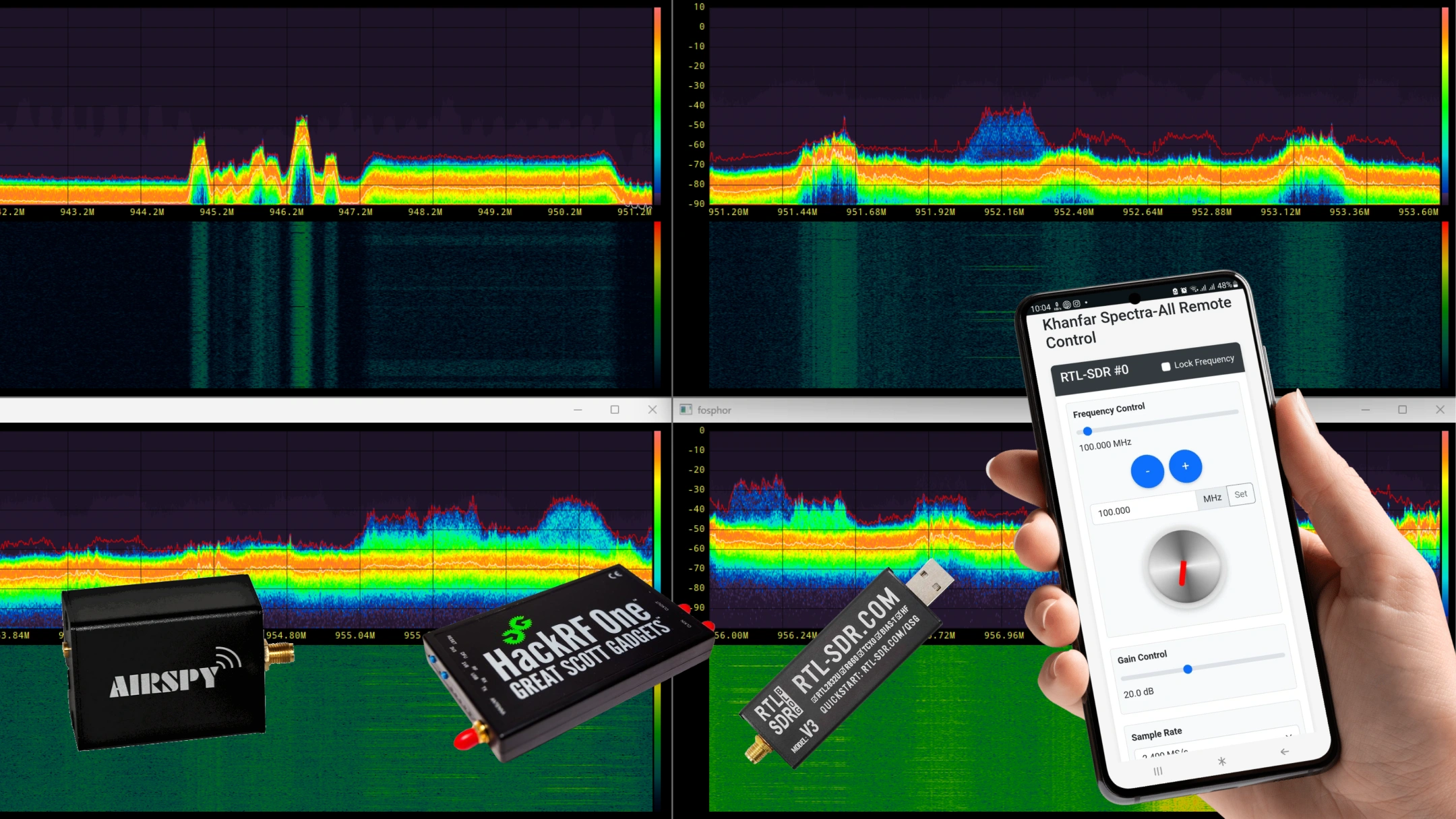
Khanfar Spectra-All v1.2 - New Feature Spotlight
The latest version of our multi-device SDR software with a revolutionary LAN Command Controller for complete remote operation.
LAN Command Controller: Remote SDR Control From Any Device
We're excited to announce a powerful new addition to Khanfar Spectra-All v1.2: the LAN Command Controller. This feature transforms your SDR experience by enabling full remote control of your SDR devices from anywhere on your local network.
Key Features:
Cross-Platform Web Interface
- Control from any web browser
- Works on Windows, macOS, Linux, Android, iOS
- No app installation required
Mobile-Optimized Experience
- Responsive design for all devices
- Touch-optimized precise controls
- Virtual rotary tuning knob
- Long-press scanning buttons
Real-time Monitoring
- WebSocket live updates
- Instantaneous control response
- Real-time scanning progress
Comprehensive Control
- Multiple input methods (precision fields, sliders, knob, buttons)
- Adjust gain and sample rate
- Configure scanning parameters
- Lock frequencies across devices
Easy Setup
- One-click activation
- Auto IP detection
- Instant browser access
- QR code quick-connect
How It Works
The LAN Command Controller creates a secure web server on your local network, allowing any device with a web browser to connect and control your SDR setup. The interface updates in real time, ensuring you always see the current state of your devices.
Perfect for:
- Remote monitoring setups
- Collaborative signal hunting
- Controlling your SDR from the comfort of your couch
- Educational demonstrations
- Multi-operator signal intelligence
Getting Started
- Click the "LAN Command Controller" button in any Khanfar Spectra-All window
- Note the displayed URL (or scan the QR code with your mobile device)
- Access the control interface from any browser on your local network
- Enjoy full control of your SDR devices from anywhere in your home or office
The Khanfar Spectra-All v1.2 LAN Command Controller puts professional-grade SDR control in your pocket, making SDR operation more convenient and accessible than ever before.

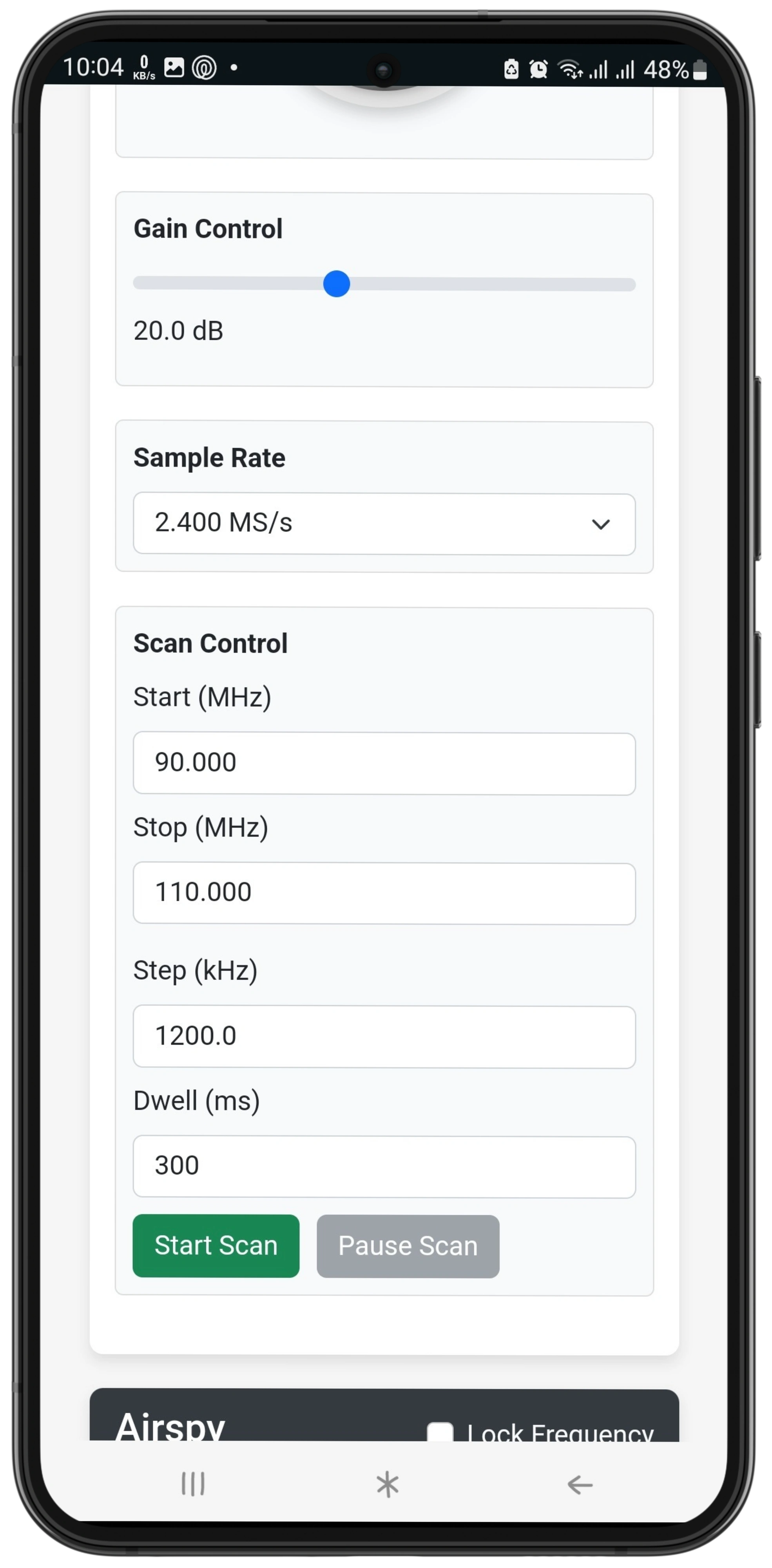
Version 1.2 (Beta) - Includes LAN Command Controller
Unzip Password: 1234
Support Our Development
Our SDR hobby tools are developed with passion and dedication to the RF community. Your donations help us continue creating new features and tools. If you find our software useful, please consider supporting our work.
Donate via PayPalConnect With Us
Important Security Note
Some antivirus software may flag our executables as potentially suspicious. This is a common false positive issue with software compiled using PyInstaller.
Why Antivirus Engines Flag Python Executables
- Packing Mechanism: Tools like PyInstaller bundle Python code into a single executable using compression/encryption techniques similar to those used by some malware
- Heuristic Detection: Antivirus engines may flag large Python libraries (PyQt6, NumPy, etc.) as suspicious without analyzing their actual content
- False Positives: Generic detection names (W64.AIDetectMalware, Spy.Win64.Keylogger.oa!s1) indicate low-confidence flags
- Third-Party Dependencies: Uncommon DLLs or shared objects might trigger alerts
Our software is 100% safe and contains no malicious code.